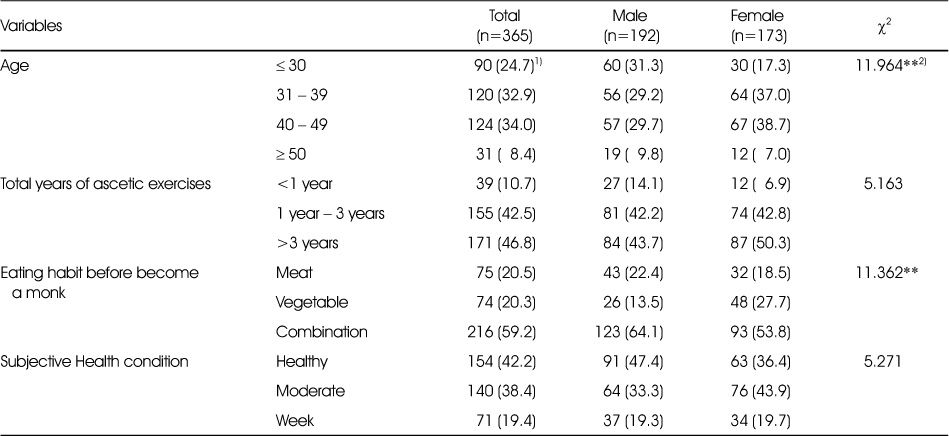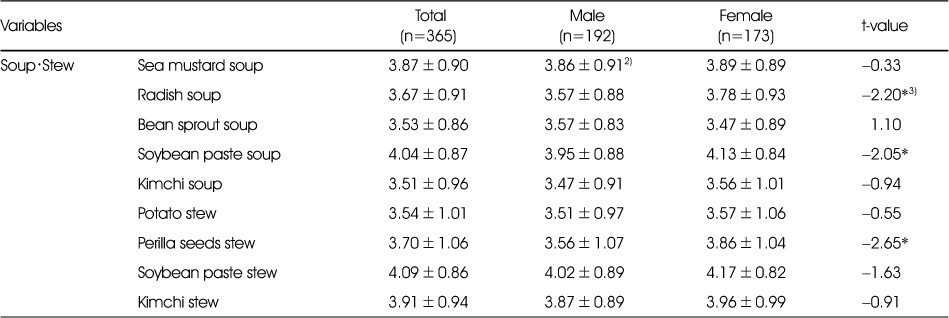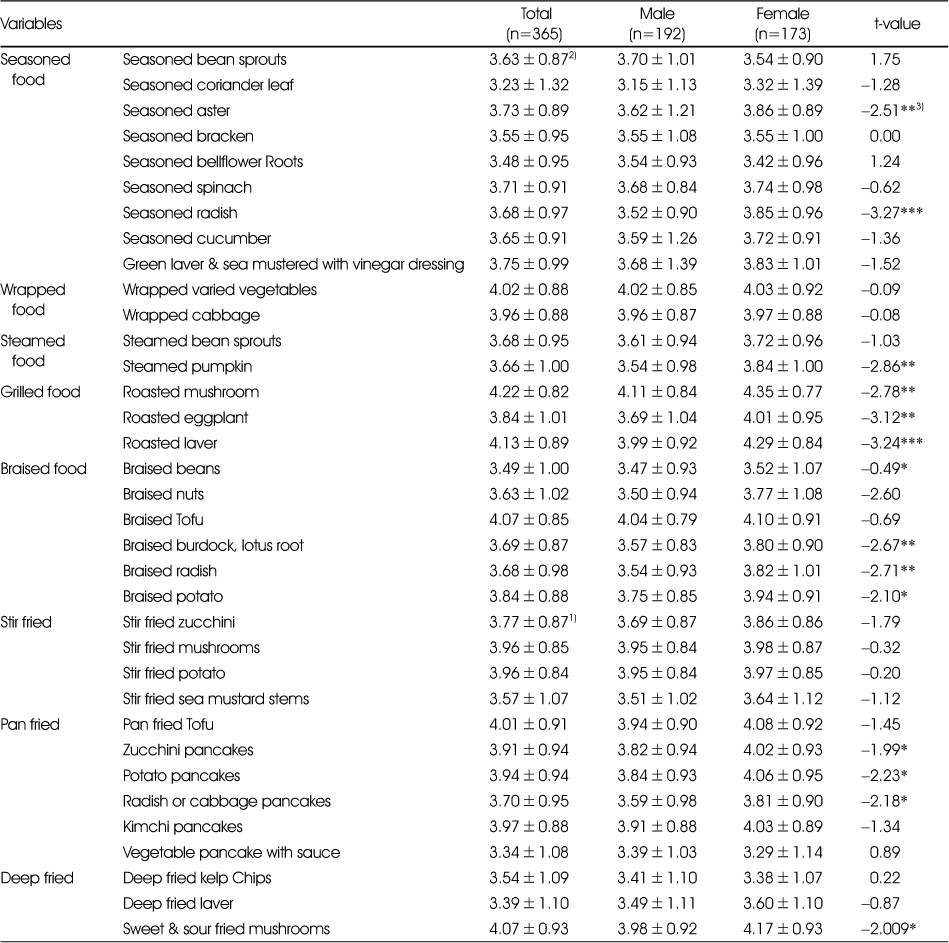Articles
- Page Path
- HOME > Korean J Community Nutr > Volume 22(5); 2017 > Article
-
Research Article
- A Study on Dietary Behavior and Food Preference of Sramanera·Sramanerika Monks in Nationwide Buddhist Monk's Universities
-
Su-Jin Han, Sim-Yeol Lee

-
Korean Journal of Community Nutrition 2017;22(5):387-400.
DOI: https://doi.org/10.5720/kjcn.2017.22.5.387
Published online: October 31, 2017
1Department of Culinary Education, Graduate School of Education, Dongguk University, Seoul, Korea.
2Department of Home Economics Education, Graduate School of Dongguk University, Seoul, Korea.
- Corresponding author: Sim-Yeol Lee. Department of Home Economics Education, Graduate School of Dongguk University, Seoul 04620, Korea. Tel: (02) 2260-3413, Fax: (02) 2265-1170, slee@dongguk.edu
Copyright © 2017 The Korean Society of Community Nutrition
This is an Open-Access article distributed under the terms of the Creative Commons Attribution Non-Commercial License (http://creativecommons.org/licenses/by-nc/3.0/) which permits unrestricted non-commercial use, distribution, and reproduction in any medium, provided the original work is properly cited.
- 1,341 Views
- 4 Download
- 2 Crossref
Abstract
-
Objectives
- This study was designed to find out factors that are needed to be improved for the Buddhist training environment of Sramanera·Sramanerika monks, who have been newly adapted for their life style after becoming a monk, and to provide basic data for the development of the standard diet in Buddhist temples.
-
Methods
- A self-administered questionnaire was applied to 365 Sramanera·Sramanerika monks at 11 Buddhist monk universities. The questionnaire was designed to investigate their dietary habits, dietary evaluation, satisfaction of food service, and food preferences.
-
Results
- The study population consisted of 52.6% men, and 47.4% women. The subjects who had a vegetarian diet before joining the Buddhist priesthood were 27.7% women, and 13.5% men (p<0.01). 42.2% of the total subjects felt that they are healthy now and 19.4% felt weak. The most difficulty of dieting adaptation as soon as entering the priesthood was the strict diet rules (42.9%). The subjects considered health or nutrition (40.0%) highly when having meals. 94.8% women, 84.1% men ate breakfast every day (p<0.001). Women (55.4%) frequently ate snacks more than men (26.6%) (p<0.001). The results of the dietary evaluation indicated that the intake of milk, soy milk or dairy products and beans or tofu received lower than 3 points and women had lower point result than men (p<0.001). Foods with higher preference were grilled mushrooms, grilled laver, miso stew, sweet and sour mushrooms, steamed tofu with seasoning.
-
Conclusions
- Women were more interested in their health than men but they also required to improve the nutritional eating habits. It appeared that the lower intake rates of the calcium containing food (milk and dairy), and proteins (beans and tofu) could result in nutritional imbalance. Therefore, it is necessary to offer food based on the standard menu plan with consideration given to their food preferences in order to maintain their health and desirable dietary habits.
- 1. Kong MS. A study of the relations between food and meditation in the early Buddhism. Stud Seon Cult 2008; 4: 1-35.
- 2. Seo HG. Food culture of Buddhism. Asian Comp Folk 2003; 24: 197-226.
- 3. Han TS. Current state of entering the Buddhist priesthood in Korean Buddhist Jogye Order and improvement suggestion for entering the Buddhist priesthood system. J Maha Bodhi Thought 2012; 17: 209-243.
- 4. Lin QL, Kim HK. A prediction model on adaptation to university life among Chinese international students in Korea. J Korean Acad Soc Nur Educ 2011; 17(3): 501-513.Article
- 5. Huang B, Rodriguez BL, Burchfiel CM, Chyou PH, Curb JD, Yano K. Acculturation and prevalence of diabetes among Japanese-American men in Hawaii. Am J Epidemiol 1996; 144(7): 674-681.ArticlePubMed
- 6. Shin SM, Bae HJ. Survey on menu satisfaction and preferences of high school boarding students in Gyeonggi province. Korean J Food Cook Sci 2010; 26(4): 347-357.
- 7. Einstein MA, Hornstein I. Food preference of college students and nutritional implications. J Food Sci 1970; 35(4): 429-436.
- 8. Noh HJ. A study on the deviation behaviors of the military [master's thesis]. Ewha Woman's University: 2012.
- 9. Yoon JS, Lee WJ. A nutritional survey of Buddhist nuns. Korean J Nutr 1982; 15(4): 268-276.
- 10. Yoo YS, Lee YH. A study on the dietary life and nutritional status of the Buddhist priests. J East Asian Soc Diet Life 1996; 6(3): 425-434.
- 11. Cha BK, Lee SJ. A nutritional survey of Buddhist nuns. J East Asian Soc Diet Life 1997; 7(1): 107-115.
- 12. Park HY, Lee SY, Lee YH. A study of dietary life and state of health of Buddhist nuns in the Seoul area. J East Asian Soc Diet Life 2002; 12(5): 343-351.
- 13. Kim DI, Choi MS, Jeong JC. A study on health status and health promotion behavior of Korean Buddhist nuns. J Ori Obst Gynecol 2004; 17(3): 133-148.
- 14. Kim JA, Lee SY. Evaluation of served menu and management of foodservice in Korean Buddhist temples. J East Asian Soc Diet Life 2006; 16(2): 215-225.
- 15. Kim JA, Lee SY. Nutritional evaluation of served menu in Korean temples. Korean J Nutr 2007; 40(2): 172-181.
- 16. Kim ES, Jung BM. A survey of satisfaction and preference for military meal service and food behaviors and food habits of some military personnel. Korean J Community Nutr 2006; 11(4): 520-533.
- 17. Lee KH, Park ES. School food service satisfaction and menu preferences of high school students: Focused on Iksan, Cheonbuk. Korean J Community Nutr 2010; 15(1): 108-123.
- 18. National Health Insurance Service. National screening programevaluation of diet habits 2016 [Internet]. National Health Insurance Service; 2016; cited 2016 Jan 27]. Available from: http://www.nhis.or.kr.
- 19. Cho EJ, Park SH. A study on eating habits of the Buddhist priesthood in Seoul and Kyongnam. Korean J Diet Cult 1994; 9(2): 111-118.
- 20. Kim JA. Nutritional evaluation of served menu and management of foodservice in Korean temples [dissertation]. Dongguk University; 2004.
- 21. Nam HJ, Lee SD, Kim YS. Medicinal food in the traditional Buddhist temple food. J Health Sci Med Technol 2005; 31(2): 17-27.
- 22. Lee KE, Hong WS, Kim MH. Student's food preferences on vegetarian menus served at middle and high schools. J Korean Diet Assoc 2005; 11(3): 320-330.
- 23. Lee SY, Kim JA. The development of institutional food-service menu with temple food. Korean J Community Nutr 2015; 20(5): 338-350.Article
- 24. Institution Reference. Research on the cognition of the vegetarian eating habits. Embrain Trend Monitor 2012; 2012(8): 42-79.
- 25. Kang YK. Veginomics [Internet]. Yonhapmidas; 2017; cited 2017 May 20]. Available from: http://www.yonhapmidas.com/article/170607190440_408060.
- 26. Ju YJ, Kang JY, Chung JY. Characteristic of vegetarianism and its association with eating behavior in women living in Seoul. J Korean Soc Diet Cult 2013; 28(6): 576-584.
- 27. Ryu SH, Cho YH, Han YR. Adaptation for Korean foods and satisfaction for food service by different residence periods of Chinese and Japanese university students in Daejeon. J East Asian Soc Diet Life 2014; 24(1): 143-155.Article
- 28. Ministry of health & Welfare, Korea Center of Disease Control and Prevention. Korea health statistics 2014: Korea National Health and Nutrition Examination Survey (KNHANES VI-2) [Internet]. Ministry of health & Welfare, Korea Center of Disease Control and Prevention; 2015; cited 2016 Dec 21]. Available from: https://knhanes.cdc.go.kr.
- 29. Ministry of health & Welfare, Korea Center of Disease Control and Prevention. Korea Health Statistics 2013: Korea National Health and Nutrition Examination Survey (KNHANES VI-1) [Internet]. Ministry of health & Welfare, Korea Center of Disease Control and Prevention; 2014; cited 2015 Dec 24]. Available from: https://knhanes.cdc.go.kr.
- 30. Kim HK. Intake patterns and preference of soy foods by age and gender in Ulsan area. J Human Ecol 2005; 7(1): 1-17.
- 31. Kim SH, Han JH, Kim WY. Health functional food use and related variables among the middle-aged in Korea. Korean J Nutr 2010; 43(3): 294-303.Article
- 32. Yoo YS, Lee SY. Dietetics. 4th revision. Seoul: Gyomoonsa; 2000. p. 181.
- 33. Watanabe F, Yabuta Y, Bito T, Teng F. Vitamin B12 containing plant food sources for vegetarians. Nutrients 2014; 6(5): 1861-1873.ArticlePubMedPMC
- 34. Bito T, Teng F, Ohishi N, Takenaka S, Miyamoto E, Sakuno E. Characterization of vitamin B12 compounds in the fruiting bodies shiitake mushroom and bed logs after fruiting of the mushroom. Mycoscience 2014; 55(6): 462-468.Article
- 35. Kwak CS, Hwang JY, Watanabe F, Park SC. Vitamin B12 contents in some Korean fermented foods and edible seaweeds. Korean J Nutr 2008; 41(5): 439-447.
- 36. Lee YJ, Krawinkel M. The nutritional status of iron, folate, and vitamin B-12 of Buddhist vegetarians. Asia Pac Clin Nutr 2011; 20(1): 42-49.
- 37. Park YS, Lee AR. Sodium intakes by liquid dishes of Korean ordinary meals. Soonchunhyang J Nat Sci 2010; 16(2): 159-165.
- 38. Park YS, Lee AR. Sodium levels of ready-to-eat foods and snakes. Soonchunhyang J Nat Sci 2011; 17(2): 129-134.
- 39. Yun MJ, Lee MS, Choi MS. A study on gruel intake and preference of Cheongju area adults and gruel development according to age. Korean J Community Living Sci 2009; 20(3): 449-460.
- 40. Weon MK, Lee YJ. Consumer's perception, preference and intake frequency of Jangachi (Korean pickle) by age for developing low salt Jangachi. Cul Sci Hosp Res 2013; 19(5): 249-263.Article
REFERENCES
Figure & Data
REFERENCES
Citations

- Dietary Behavior and Food Preferences of Buddhist Monks in Korean Temples
Choong-Sun Lim, Sim-Yeol Lee
Journal of the East Asian Society of Dietary Life.2023; 33(4): 331. CrossRef - Vegetarianism as a protective factor for asymptomatic colonic diverticulosis in Asians: a retrospective cross-sectional and case-control study
Jihun Bong, Hyoun Woo Kang, Hyeki Cho, Ji Hyung Nam, Dong Kee Jang, Jae Hak Kim, Jun Kyu Lee, Yun Jeong Lim, Moon-Soo Koh, Jin Ho Lee
Intestinal Research.2020; 18(1): 121. CrossRef
General characteristics of the study subjects
1) N (%)
2) **: p<0.01
Adaptation of eating habits & standard of food choices by the gender
1) N (%)
2) *: p<0.05, **: p<0.01
Eating behavior by the gender
1) N (%)
2) *: p<0.05, **: p<0.01, ***: p<0.001
3) Multiple response with composed of Sum & % from 1 is reported into two equal groups.
Dietary assessment by the gender
1) Mean±SD
2) 5-point scale: 5 Always, 3 Moderate, 1 Seldom
3) 5-point scale: 1 Always, 3 Moderate, 5 Seldom
4) **: p<0.01, ***: p<0.001
Food service satisfaction by the gender
1) Scale: A 5-point scale was used from 1 (very dissatisfied) to 5 (very satisfied)
2) Mean±SD
3) ***: p<0.001
Food preference for the staple food by the gender
1) Scale: A 5-point scale was used from 1 (very dislike) to 5 (very like) & 0 (no experience)
2) Mean±SD
3) *: p<0.05, ***: p<0.001
Food preference for the soups by the gender
1) Scale: A 5-point scale was used from 1 (very dislike) to 5 (very like) & 0 (no experience)
2) Mean±SD
3) *: p<0.05
Food preference on Kimchi and pickled vegetables by the gender
1) Scale: A 5-point scale was used from 1 (very dislike) to 5 (very like) & 0 (no experience)
2) Mean±SD
3) ***: p<0.001
Food preference for the side dishes by the gender
1) Scale: A 5-point scale was used from 1 (very dislike) to 5 (very like) & 0 (no experience)
2) Mean±SD
3) *: p<0.05, **: p<0.01, ***: p<0.001
1) N (%) 2) **: p<0.01
1) N (%) 2) *: p<0.05, **: p<0.01
1) N (%) 2) *: p<0.05, **: p<0.01, ***: p<0.001 3) Multiple response with composed of Sum & % from 1 is reported into two equal groups.
1) Mean±SD 2) 5-point scale: 5 Always, 3 Moderate, 1 Seldom 3) 5-point scale: 1 Always, 3 Moderate, 5 Seldom 4) **: p<0.01, ***: p<0.001
1) Scale: A 5-point scale was used from 1 (very dissatisfied) to 5 (very satisfied) 2) Mean±SD 3) ***: p<0.001
1) Scale: A 5-point scale was used from 1 (very dislike) to 5 (very like) & 0 (no experience) 2) Mean±SD 3) *: p<0.05, ***: p<0.001
1) Scale: A 5-point scale was used from 1 (very dislike) to 5 (very like) & 0 (no experience) 2) Mean±SD 3) *: p<0.05
1) Scale: A 5-point scale was used from 1 (very dislike) to 5 (very like) & 0 (no experience) 2) Mean±SD 3) ***: p<0.001
1) Scale: A 5-point scale was used from 1 (very dislike) to 5 (very like) & 0 (no experience) 2) Mean±SD 3) *: p<0.05, **: p<0.01, ***: p<0.001

 KSCN
KSCN









 Cite
Cite


